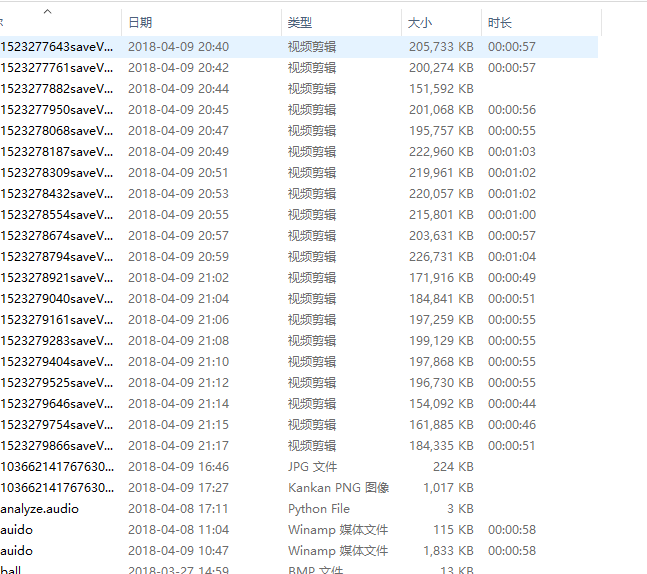添加随机扰动 爬山算法
避免陷入不动域
video_playtime = compute_video_playtime(f_v) if video_playtime - audio_spend > bear_error_second: os_delay_factor -= mystep gen_video(os_delay_factor=os_delay_factor, mystep=0.005, audio_spend=58.777058839797974) elif video_playtime - audio_spend < -bear_error_second: os_delay_factor += mystep gen_video(os_delay_factor=os_delay_factor, mystep=0.005, audio_spend=58.777058839797974) else: os._exit(123) gen_video(os_delay_factor=1, mystep=0.005, audio_spend=58.777058839797974)
控制步长参数和时延阈值,通过递归函数,实现音视频的同步问题。
import os
import os, time, glob
import cv2
os_sep = os.sep
this_file_abspath = os.path.abspath(__file__)
this_file_dirname, this_file_name = os.path.dirname(this_file_abspath), os.path.abspath(__file__).split(os_sep)[
-1]
f_img_d = '{}{}{}{}{}'.format(this_file_dirname, os_sep, 'mypng', os_sep, '*.jpg')
imgs, img_size_d = glob.glob(f_img_d), {}
for i in imgs:
img = cv2.imread(i)
w_h_s = '{},{}'.format(img.shape[1], img.shape[0])
if w_h_s not in img_size_d:
img_size_d[w_h_s] = 1
else:
img_size_d[w_h_s] += 1
mode_img_size_wh = [int(i) for i in
sorted(img_size_d.items(), key=lambda img_size_d: img_size_d[0], reverse=True)[0][0].split(',')]
import os
os_sep = os.sep
this_file_abspath = os.path.abspath(__file__)
this_file_dirname, this_file_name = os.path.dirname(this_file_abspath), os.path.abspath(__file__).split(os_sep)[-1]
f_mp3 = '{}{}{}'.format(this_file_dirname, os_sep, 'auido.mp3')
from playsound import playsound
import time
import math
this_time = time.time()
# playsound(f_mp3)
# t_spend = time.time() - this_time
t_spend = 58.777058839797974
# 音频的秒数
t_spend = math.ceil(t_spend)
import cv2
import glob
'''
python+opencv视频图像相互转换 - CSDN博客 https://blog.csdn.net/m0_37733057/article/details/79023693
链接:https://www.zhihu.com/question/49558804/answer/343058915
OpenCV: Drawing Functions in OpenCV https://docs.opencv.org/3.1.0/dc/da5/tutorial_py_drawing_functions.html
'''
# 每秒传输帧数(Frames Per Second)
fps = 100 # 保存视频的FPS,可以适当调整 FPS是图像领域中的定义,是指画面每秒传输帧数,通俗来讲就是指动画或视频的画面数。FPS是测量用于保存、显示动态视频的信息数量。每秒钟帧数愈多,所显示的动作就会愈流畅。通常,要避免动作不流畅的最低是30。某些计算机视频格式,每秒只能提供15帧。
f_img_d = '{}{}{}{}{}'.format(this_file_dirname, os_sep, 'mypng', os_sep, '*.jpg')
imgs = glob.glob(f_img_d)
"""
用图片总数均分音频时间
"""
os_delay_factor = 0.14
os_delay_factor = 0.11
myinterval = t_spend / len(imgs) * os_delay_factor
f, l = 'mybaidu.parp.txt', []
with open(f, 'r', encoding='utf-8') as fr:
for i in fr:
ii = i.replace('
', '')
l.append(ii)
char_loop_l = []
for i in l:
mystr, le = '', len(i)
for ii in range(le):
iii = i[ii]
print('-----', iii)
mystr = '{}{}'.format(mystr, iii)
print(mystr)
char_loop_l.append(iii)
#
# from fontTools.ttLib import TTFont
# myfont = TTFont('simhei.ttf')
def resize_rescale_pilimg(img_f, w_h_tuple=(mode_img_size_wh[0], mode_img_size_wh[1]), mid_factor=1):
img_n, img_type = img_f.split('.')[-2], img_f.split('.')[-1]
img_type = 'PNG'
img_f_new = '{}{}{}{}'.format(img_n,int(time.time()), 'resize_rescale.', img_type)
mid_icon = Image.open(img_f)
mid_icon_w, mid_icon_h = w_h_tuple[0] * mid_factor, w_h_tuple[1] * mid_factor
mid_icon = mid_icon.resize((mid_icon_w, mid_icon_h), Image.ANTIALIAS)
mid_icon.save(img_f_new, img_type)
return img_f_new
def compute_video_playtime(f):
# Create a VideoCapture object and read from input file
# If the input is the camera, pass 0 instead of the video file name
cap = cv2.VideoCapture(f)
# Check if camera opened successfully
if (cap.isOpened() == False):
print("Error opening video stream or file")
# Read until video is completed
while (cap.isOpened()):
# Capture frame-by-frame
ret, frame = cap.read()
if ret == True:
# Display the resulting frame
cv2.imshow('Frame', frame)
# Press Q on keyboard to exit
if cv2.waitKey(25) & 0xFF == ord('q'):
break
# Break the loop
else:
break
# When everything done, release the video capture object
cap.release()
# Closes all the frames
cv2.destroyAllWindows()
return time.time() - this_time
from PIL import Image, ImageDraw, ImageFont
myfont = ImageFont.truetype("simhei.ttf", 50, encoding="utf-8")
import cv2
import numpy as np
def gen_video(os_delay_factor=0.245, mystep=0.01,bear_error_second=1, audio_spend=58.777058839797974):
f_v = '{}{}'.format(int(time.time()), 'saveVideo.avi')
fps, fourcc = 15, cv2.VideoWriter_fourcc('M', 'J', 'P', 'G')
# fourcc = cv2.VideoWriter_fourcc('M', 'J', 'P', 'G') # opencv3.0
videoWriter = cv2.VideoWriter(f_v, fourcc, fps, (mode_img_size_wh[0], mode_img_size_wh[1]))
f_v = '{}{}'.format(int(time.time()), 'saveVideo.avi')
myinterval = t_spend / (len(char_loop_l) * 1) * os_delay_factor
for i in l:
i_index = l.index(i)
img_index = i_index % len(imgs)
imgname = imgs[img_index]
mystr, le = '', len(i)
for ii in range(le):
iii = i[ii]
print('-----', iii)
if len(mystr) % 15 == 0:
mystr = '{}{}'.format(mystr, '
')
mystr = '{}{}'.format(mystr, iii)
print(mystr)
this_time = time.time()
while time.time() - this_time < myinterval:
print(imgname)
frame = cv2.imread(imgname)
del_f=False
if (frame.shape[1], frame.shape[0]) != (mode_img_size_wh[0], mode_img_size_wh[1]):
imgname = resize_rescale_pilimg(imgname)
frame = cv2.imread(imgname)
del_f = True
else:
pass
frame_cv2 = cv2.cvtColor(frame, cv2.COLOR_BGR2RGB)
frame_pil = Image.fromarray(frame_cv2) # 转为PIL的图片格式
font = ImageFont.truetype("simhei.ttf", 50, encoding="utf-8")
# 第一个参数为字体,中文黑体
# 第二个为字体大小
ImageDraw.Draw(frame_pil).text((100, 20), mystr, (0, 0, 255), font)
'''
frame_pil:目标图像
第一个参数为打印的坐标
第二个为打印的文本
第三个为字体颜色
第四个为字体
'''
frame_cv2 = cv2.cvtColor(np.array(frame_pil), cv2.COLOR_RGB2BGR)
img = frame_cv2
videoWriter.write(img)
if del_f:
if os.path.exists(imgname):
print(imgname)
print('del')
# 删除文件,可使用以下两种方法。
os.remove(imgname)
# os.unlink(my_file)
else:
pass
videoWriter.release()
time.sleep(3)
video_playtime = compute_video_playtime(f_v)
if video_playtime - audio_spend > bear_error_second:
os_delay_factor -= mystep
gen_video(os_delay_factor=os_delay_factor, mystep=0.005, audio_spend=58.777058839797974)
elif audio_spend- video_playtime > bear_error_second:
os_delay_factor += mystep
gen_video(os_delay_factor=os_delay_factor, mystep=0.005, audio_spend=58.777058839797974)
else:
os._exit(123)
gen_video(os_delay_factor=1, mystep=0.005,bear_error_second=0.5, audio_spend=58.777058839797974)
'''
'''
from PIL import Image
#
#
# logo = 'fugu.png'
# mid_icon = Image.open(logo)
# mid_icon_w, mid_icon_h = mid_icon.size
# mid_factor = 5
# mid_icon_w, mid_icon_h = mid_icon_w * mid_factor, mid_icon_h * mid_factor
# mid_icon = mid_icon.resize((mid_icon_w * 3, mid_icon_h), Image.ANTIALIAS)
# mid_icon.save('fugu.2.png', 'PNG')
